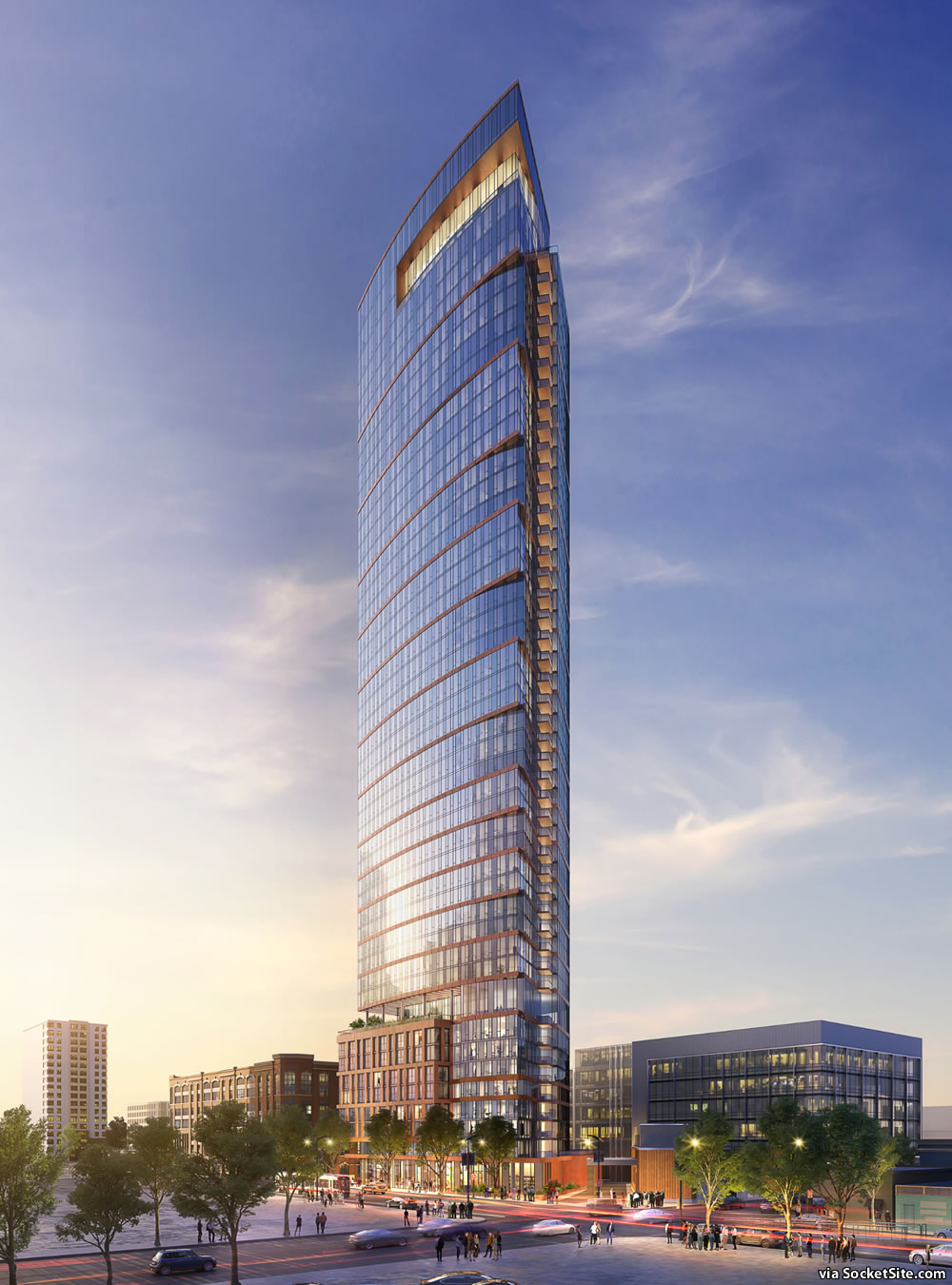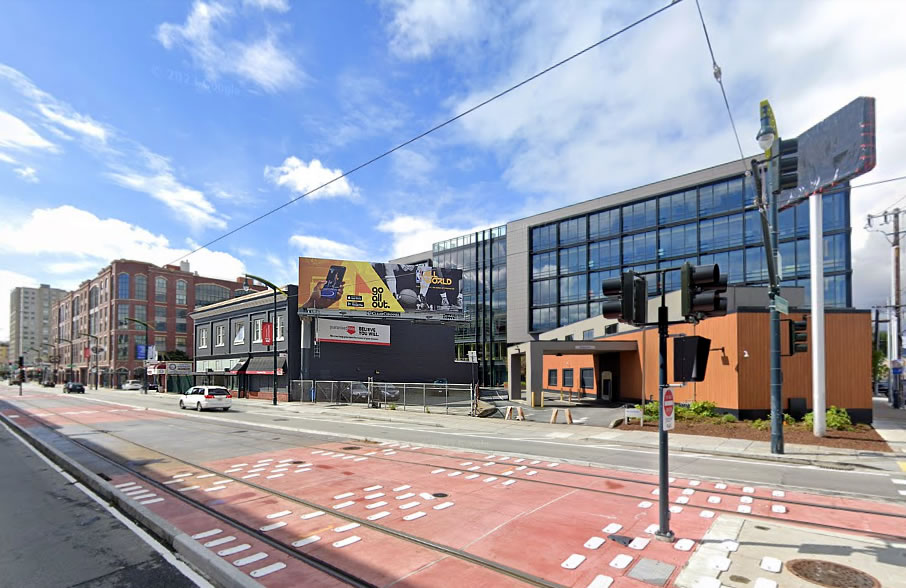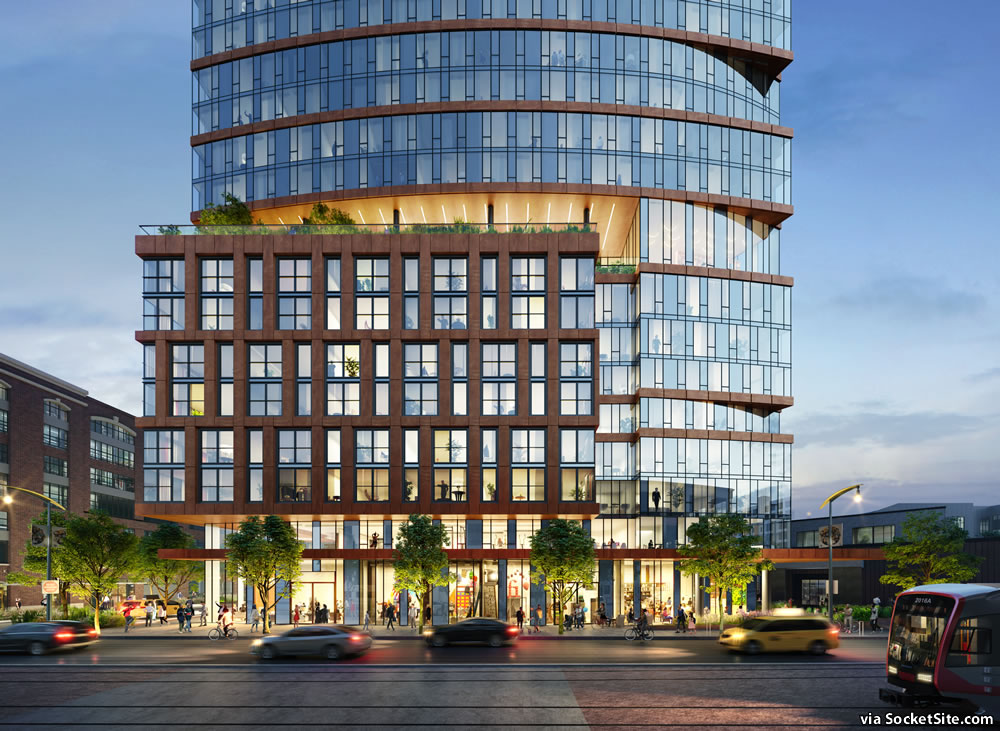As we revealed earlier this year, plans for a supersized tower to rise up to 451-feet in height upon the former K&L Wine Merchants building parcel at 636-638 4th Street were in the works.
Since refined by SCB for the Solbach Property Group as newly rendered above and below, the proposed 47-story tower would now reach a height of 517 feet, with 520 residential units, a mix of 122 studios, 187 one-bedrooms, 206 twos, and 5 threes, over 3,270 square feet of ground floor retail space and underground parking for 130 cars, leveraging a State Density Bonus for the height, density and mass as proposed, in exchange for which 87 of the units would need to be offered at below market rates.
Assuming the plans are entitled, the project team is now projecting that the existing buildings on the site would/could be demolished in the first quarter of 2025; the foundation for the tower would/could be laid later that year; and that the tower would/could be completed in mid-2027, at the earliest. And no, applications to secure demolition and building permits for the development, in order to be parallel processed and prepared to break ground, have yet to be submitted to the City. We’ll keep you posted and plugged-in.



When the feds gave a billion dollars to the Central Subway it should have come with conditions that projects like these get rubber-stamped in 90 days or less. This is exactly the kind of project needed to convert the Central Subway from boondoggle to investment.
Very true! Well said.
Agree, but it presumes that the Central Subway was designed to actually go to a place that people wanted to go. This seems to be another one of the MTA/ DPW boondoggles designed to employ a litany of people and deliver a subway line to a favored neighborhood, irrespective of meaningful ridership.
Like many SF infrastructure projects (see: transbay terminal)
So… the city connects a new, largely populated neighborhood that has a massive campus, hospital, and arena to the densest and one of the most highly trafficked neighborhoods (Chinatown) while simultaneously speeding up the travel time between one of the last remaining working-class areas (Bayview / Hunters Point) and the commercial core of the city (not to mention, art museums, convention center) and you think it’s a conspiracy???
Yes– look at the ridership. And look at the alignment chosen. Yes.
Look at the ridership in context of other Muni ridership. And look at ridership on game day.
This isn’t the Second Avenue Subway. It’s not going to be packed to the gills. It’s a tragedy that it wasn’t built to North Beach in the first segment, but it’s still a useful piece of infrastructure as it is.
👏 👏 👏 @Bobby Mucho
It’s not a conspiracy to note that there was no arena when the Central Subway was planned.
It’s the right idea, but the wrong alignment. It should have gone from the Bayview up 3rd Street and connected with the Transbay Terminal. The whole point of building the Transbay Terminal was a multimodal transportation hub.
Instead, we have a slow subway between Chinatown and Moscone, which makes no sense, but which was very expensive.
Further up in this thread, Kyle S. mentioned the Second Avenue Subway in New York City. Well, the most recently-constructed segment cost $2.6 billion per mile. Our Central Subway cost $920 million per mile. The L.A. Purple Line cost $800 million per mile.
The Paris metro cost $160 million per mile. Madrid’s subway cost $320 million per mile. In short, every subway system in the U.S. is very expensive and the Central Subway would have been just as expensive regardless of its alignment.
Yes, it would have been expensive no matter the alignment. However, the alignment could have been much better. If we are going to spend $1billion/mile, then we might as well build the subway which makes the most sense.
Actually, travel times are often longer on the T line than the former #15 bus line.
I can walk from The Palms to my destination 4th/Market faster than taking the Central Subway.
There’s a lot going wrong at City&County agencies, and you can credibly send a lot of blame their way. The Central Subway though is not one of the litany of ills. That’s come out of deal brokered with Rose Pak to make up for the “loss” and demolition of the Embarcadero Freeway.
True, but they agreed to it. Rose Pak was never elected to anything. City&County agencies, or the elected officials of this city, could have stood up and said “This makes no sense”. But no one ever did.
“Rose Pak was never elected to anything”
Neither was Ben Franklin – ‘cept of course for all the yeah-but-that-doesn’t-count things he was elected to (you get the idea) . The point being that influence and incumbency aren’t one-and-the-same.
Yes, Ben Franklin and Rose Pak each were influential.
But Ben Franklin never advocated for a huge government boondoggle to benefit his own constituents ahead of the public good. The point is that no one in city government stood up to Rose Pak, and now we are stuck with a slow subway taking the wrong route. We have permanently lost the opportunity to build the subway which should have been built.
(And, by the way, check your history. Ben Franklin was influential and was elected to several positions over the course of his life.)
“agreed to it”. This is not how the cookie crumbles.
Uh huh. There were plenty of people, both elected and appointed, who “stood up and said “This makes no sense” at the time. The decision to proceed with the alignment we got was due to other people, elected, appointed and regular citizens, out organizing the people who thought it made “no sense”. The people who won out thought it “made sense”.
That is an important part of what politics in a democracy is about.
If there were people who said it made no sense, they didn’t do so until too late and they didn’t matter. (Looking at you, Aaron Peskin)
The point is that the important officials, elected and appointed, let the Central Subway happen because Rose Pak wanted it to happen.
Keep in mind that the parcel was previously up-zoned from 85 to 250 feet in height, based on it fronting the Central Subway corridor, and plans for a code-compliant, 271-unit tower to rise on the site were drawn, plans which likely could have been “rubber-stamped” a few years ago, prior to the development team choosing to pursue a supersized entitlement for the site.
What are the chances that the now-defunct BofA branch can be brought into this proposal? And what would it do to the scope of the project with the bigger footprint?
San Francisco should be building, rubber stamping these type of high rises all over SOMA
Because all the empty ones sitting and the ones still being built aren’t enough? Build them for whom exactly?
Have you heard of the housing issues we have in California? We need all types of housing
Ron, there are typically 10k units for rent in SF. I don’t see more units needed until that # moves towards 5k….
Biggest pain point: Workforce family housing. This tower [isn’t] that. That’s not to say this project shouldn’t be built.
Agreed, but FWIW, the fact that there are more two bedrooms than one bedrooms or studios is a small win. We need more three and four bedrooms for sure.
Apartments are like trees: the best time to build one was yesterday. What’s luxury now will be affordable in 40 years.
Beautifully said, couldn’t agree more
Why do you act like these buildings have a negative impact? They don’t. We need more of this and SOMA, right next to a brand new subway, is the perfect place.
Clearly, a better location (vs the Outer Sunset) for a 500+ ft residential tower if you ask me.
The developer has a nice runway before deciding to move forward, or not, with this project. There should be a clearer picture of the situation downtown by 2025. For now, the City Controller’s office has said multi-unit residential construction does not pencil – even with reduced inclusionary requirements. Speaking of which, the 87 BMR units come out at about 16% which is the proposed (enacted?) number. Down from 22%/24%.
Of note – SF’s housing production dropped almost 50% in 2022. 2910 new units. It’s expected to drop further in the immediate ensuing years. Office vacancy rose in Q2 to almost 32% per CBRE. Breed is pushing AI as one option for filling some of the empty offices. Those types of jobs could rebound demand for pricey market rate housing such as this will be. Supervisor Safai, who may run against Breed for mayor, is especially aggressive about this. Raising the alarm about a SOMA AI firm planning to triple its 500-person workforce in the next few years and which is considering a move to SSF or the Peninsula. Hopefully Breed and the City PTB do all they can to keep OpenAI (the presumed company) in SF.
Lots of moving parts in play which will determine if this project gets built or not.
OpenAI is in the Mission so probably someone else in question
My mistake. Article was referring to a company in the Mission. From the SFBT: “At a recent hearing on a proposal by Breed to temporarily reduce the tax levied on subleased space in the city to boost office occupancy, Supervisor Ahsha Safai said that his office has been in conversation with “a group that has about 500 employees at 18th and Harrison.””
That’s about their size, Ahsha is off on the cross street though (Florida)
He may have been trying to be coy but the 500 person AI firm looking to expand to 1500 (or even 2000) employees in a short time gives it away. Unless SF finds a way to fill a chunk of the empty office space 636/638 4th and nearby residential projects like the tower at Hawthorne/Folsom, the two towers at Bryant/Third and the mega tower near Folsom and 2nd won’t get built.
Keep in mind that there was Enough Empty Office Space for 160,000 People in San Francisco as of the end of last year, a number which is on the rise (with another shoe poised to drop).
Which brings us back to the development, Central SoMa plans and timing at hand…
AI job gains aren’t even keeping up with the jobs being lost in the crypto space. Now add the jobs that will be lost *due* to AI. I don’t see AI as any sort of huge office space savior, though it might soften the blow somewhat.
I agree wholeheartedly, but to be fair to the folks on the other side…the people advocating for AI-based companies to save downtown office space are implicitly hoping for and planning on AI job displacement, AI job losses and AI job destruction to take place largely outside of San Francisco, while the job gains get somehow concentrated in San Francisco and and environs.
And many of the cryptocurrency-related job losses were for positions that were already remote/work from anywhere. For that reason, even if the US Securities and Exchange Commission manages to sue Coinbase and Binance.US out of existence in the near term, I wouldn’t expect that to have an appreciable impact on the office market here (I’m not a commercial real estate broker).
job destruction to take place largely outside of San Francisco
Correct: the “other side” is
100312% pro-San Francisco: that the world may go down if flames doesn’t matter if the city…the City comes out ahead (the heat can be used for avocado toast without having to increase our carbon footprint).Hey! its worked for 100+ years – or at least the past 30 – but you lose the friends that might help you in the year +1.
Is anything happening with the tennis club site?
Alexandria (the developer) attempted to sell the entitlements a few years back. They were sued having to do with promised funding for sports (IIRC) and came to a settlement. Paying out several million. Presumably the entitlement is on the market now.
My understanding is that an approved site permit from SF Planning is needed before the DBI considers architectural / engineering drawings for the construction permits. Or, maybe it’s just that actual construction can’t begin until the site permit is issued?
A nice streamlined shape overall but might be better with fewer lumps and bumps